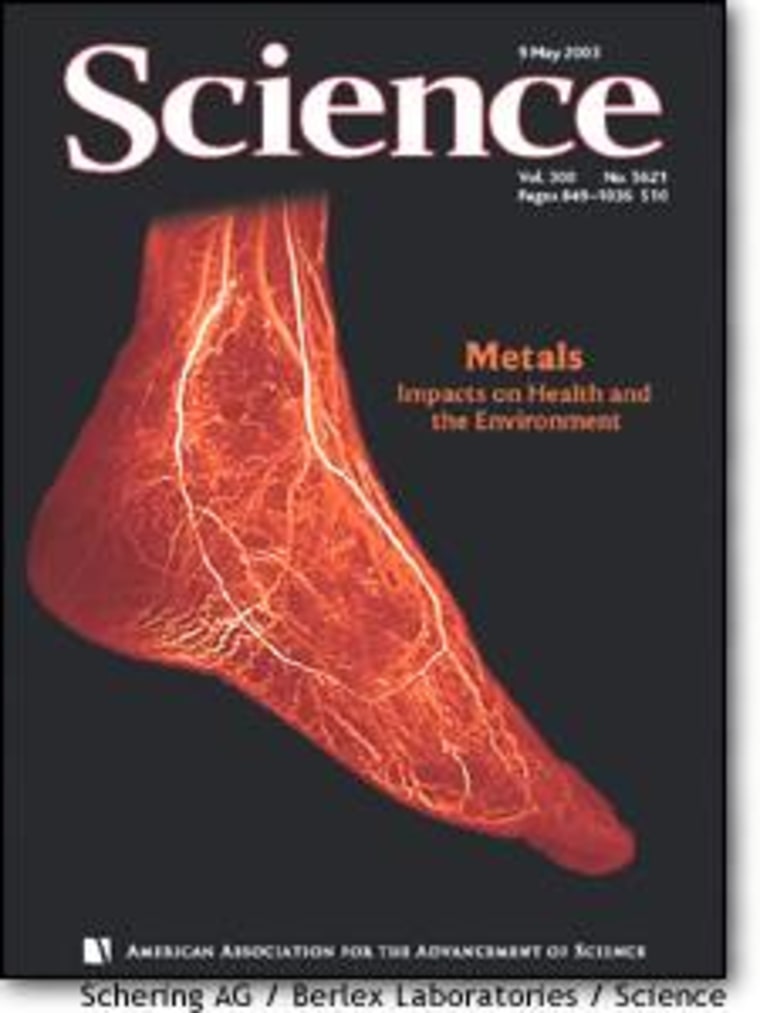Metals like arsenic are perhaps best known for their harmful effects on the body, whether they’re lurking in a community’s drinking water or in the elderberry wine of an intended murder victim. In fact, metals are essential for many of life’s basic processes. This week, a special issue of Science, published by the American Association for the Advancement of Science, reveals the double-edged nature of metals in living systems.
Metas aren't picky about interacting with other molecules, so they’re game to help in a variety of important events in the cell, such as catalyzing chemical reactions, or shuttling electrons during energy production. On the flip side, however, metals are highly reactive, and can therefore be harmful as well.
As researchers study metals in everything from microbes to humans, it’s becoming increasingly clear that a key question is “how much?” As the Swiss physician Paracelsus said in the 16th century, “The right dose differentiates between a poison and a remedy.”
Metals in medicine
Metals can be both friend and foe to human health. Check out any food label, and you’ll find a list of metals we’re supposed to include in our diets. Anemia is the most common disorder related to metal deficiency, but others include heart disease, diabetes and nerve malfunction, Katherine Thompson and Chris Orvig of the University of British Columbia write in one of the Science articles.
An overdose of other metals also can be bad news. People with a genetic disorder called Wilson’s disease must take drugs to remove toxic levels of copper from their tissues. Iron overload, whether from a genetic disease or from taking too many iron supplements, is also relatively common — and sometimes fatal.
“What we’ve found increasingly is that nature uses a wide variety of metals, in enzymes and proteins, to carry out reactions in biological systems,” says Orvig. “So the question is, if nature uses all these metals throughout the animal and plant kingdoms, why don’t we?”
Today, scientists are investigating a range of drugs that mimic the more desirable effects of certain metals. This is new ground for the pharmaceutical industry, which Orvig says has long focused on designing drugs based on organic, or carbon-based, molecules.
“There is a perception out there that metals are toxic. Especially if you use the term heavy metals, people will recoil in horror. … I think drug companies are fairly hostile to metals, which is why you see so many metal-based drugs coming from smaller startup companies,” says Orvig.
Orvig and his colleagues, for example, are working on a possible vanadium-based diabetes drug that lowers blood sugar. Tiny amounts of metals like gadolinium, when present in the body, can improve the clarity of certain imaging technologies, such as magnetic resonance imaging.
The oceans — metal deserts
While a person in a supermarket has plenty of metal-rich foods to choose from, metal availability in the ocean is a very different story. According to Francois Morel of Princeton University and Neil Price of McGill University, the microsopic plants floating around at the ocean’s surface must wring out every bit of metal they can from the water around them.
“With regard to essential micronutrients, the ocean, particularly far from land, is the most extreme environment for life on Earth,” they write in their Science article.
These mini-plants, called phytoplankton, are responsible for about half the photosynthesis on Earth, and they’re a key reason that the oceans play such an important role in removing carbon from the atmosphere.
At least a dozen of the elements phytoplankton glean from ocean water are metals, present in only in trace quantities. In spite of this scarcity, phytoplankton acquire metals with a variety of tricks, using larger molecules that bind fast to the metal ions, or sequestering complexes of metal ions in solution. These strategies may already be pushing the limits of what’s chemically and physically possible, according to Morel and Price.
An appetite for arsenic
Other micoorganisms have different dietary and energy needs altogether. As another set of Science authors report this week, bacteria that “digest” metals like arsenic and selenium have started turning up, right and left.
Scientists have discovered these bacteria in marine and freshwater sediments, hot springs, gold mines and even the gastrointestinal tracts of animals. What these environments have in common is a lack of oxygen and sunlight. So, instead of using photosynthesis, these bugs derive their energy from chemical reactions involving metals like arsenic.
“There’s this thing we know only as a nefarious poison, but when you examine the microbial world, it links directly to energy and growth,” says author Ronald Oremland of the U.S. Geological Survey.
As Oremland, along with his colleagues, has discovered new varieties of arsenic-dependent bacteria, he has come to believe that these bugs may play a significant role in “washing” arsenic off of rocky surfaces, where it occurs naturally, into aquifers and other sources of drinking water.
“Another possibility is maybe they’re out there on Mars or Europa,” Oremland proposes.
In these environments, where volcanic activity would probably make arsenic abundant, primitive microbial ecosystems might have evolved without a need for oxygen, according to Oremland.
“That’s being fanciful, but why not?” he added.
Then and now
Scientists used to draw clear boundaries between the chemistry of biological systems and the chemistry of everything else. Orvig recalls a saying he believes came from the journal of the Royal Society of Chemistry around 1890: “Organic, inorganic and physical chemistries are the sciences of the living, the dead, and the difficult.”
Today, these boundaries are crumbling, and metals are proving to be increasingly important players throughout the biological world. In fact, another pair of Science authors, from the California Institute of Technology and the University of Minnesota, think that enzymes with clusters of iron and sulfur may have helped the earliest life forms take hold on Earth.
Evolution has been carefully walking the narrow path between nutrient and poison ever since.
